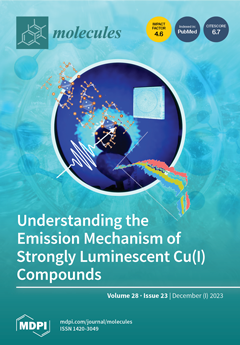Cheese consumption provides humans with minerals, proteins, carbohydrates, and vitamins. In Mexico, several cheese varieties are produced, each with its texture, scent, and flavor. The artisanal cheeses made in the states of Tabasco and Chiapas—including, among others, the varieties named
crema (cream),
doble
[...] Read more.
Cheese consumption provides humans with minerals, proteins, carbohydrates, and vitamins. In Mexico, several cheese varieties are produced, each with its texture, scent, and flavor. The artisanal cheeses made in the states of Tabasco and Chiapas—including, among others, the varieties named
crema (cream),
doble crema (double cream),
oaxaca,
panela,
fresco,
bola,
poro,
cotija, and
asadero—have a high demand in the domestic and foreign markets. The intensification of anthropic activity in these states causes an increased emission to the environment of contaminants like heavy metals, which could reach human foodstuffs through the food chains. In particular, heavy metal contents in cheeses consumed daily by these states’ local populations might represent a public health risk. Because of that, our objectives in this work were to determine the concentrations of lead, cadmium, nickel, copper, zinc, and iron in artisanal cheeses produced in the states of Tabasco and Chiapas and to determine the values of the hazard quotient (
HQ), total hazard quotient (
THQ), and cancer risk total (
CRT) for adult and young men and women. The results of our analyses of cheese samples from the states of Tabasco and Chiapas showed that the average concentrations (mg kg
−1) of cadmium (0.0023 ± 0.002, 0.0023 ± 0.002 mg kg
−1, respectively, for each state), lead (0.0047 ± 0.00, 0.0051 ± 0.002), nickel (0.0039 ± 0.0046, 0.0031 ± 0.0039), copper (0.0199 ± 0.021, 0.0202 ± 0.022), zinc (0.1611 ± 0.18, 0.194 ± 0.21), and iron (61.84 ± 4.23, 65.76 ± 6.61 mg kg
−1), the first three values lower than the limits established by the FAO/WHO and
Codex Alimentarius. The value of
THQ that we obtained was less than one, and that of
CRT was within the limits established by the US-EPA, which means that the consumption of artisanal cheeses from Tabasco and Chiapas by humans does not imply a risk of disease or cancer.
Full article






